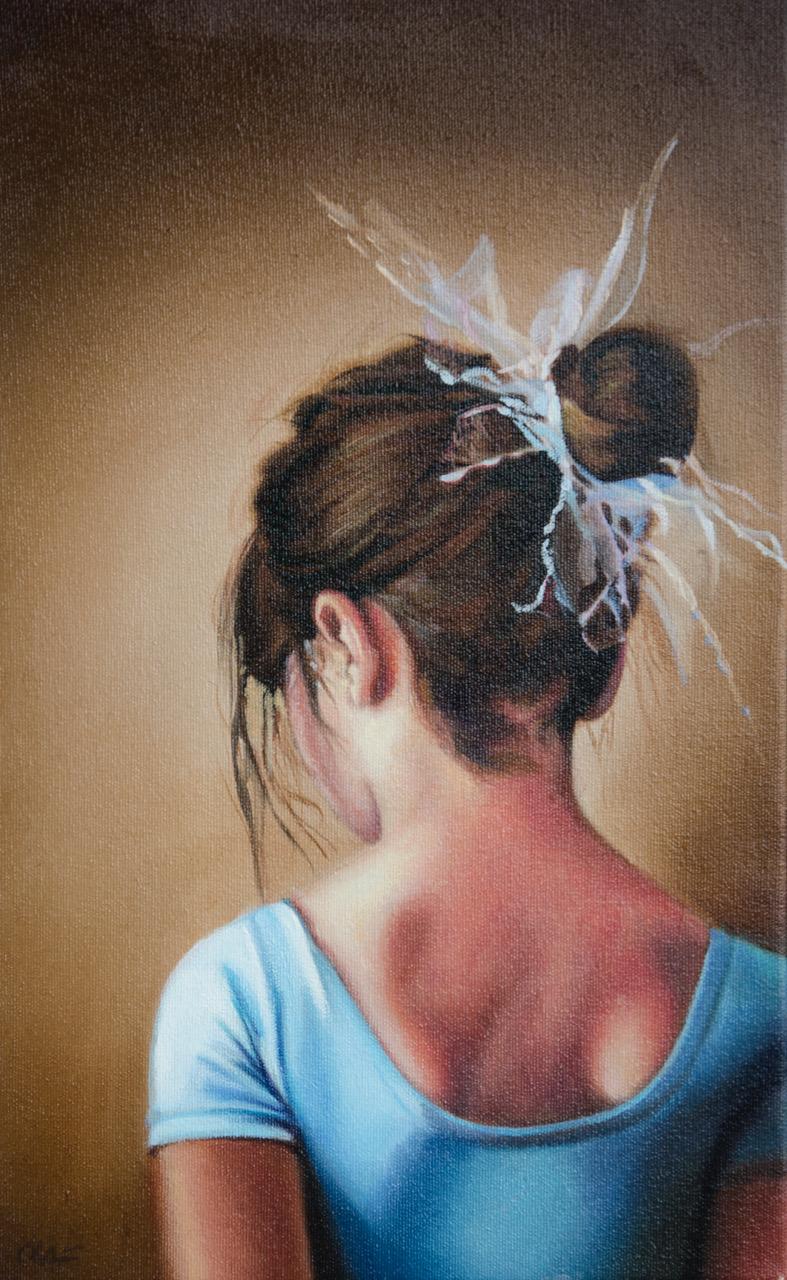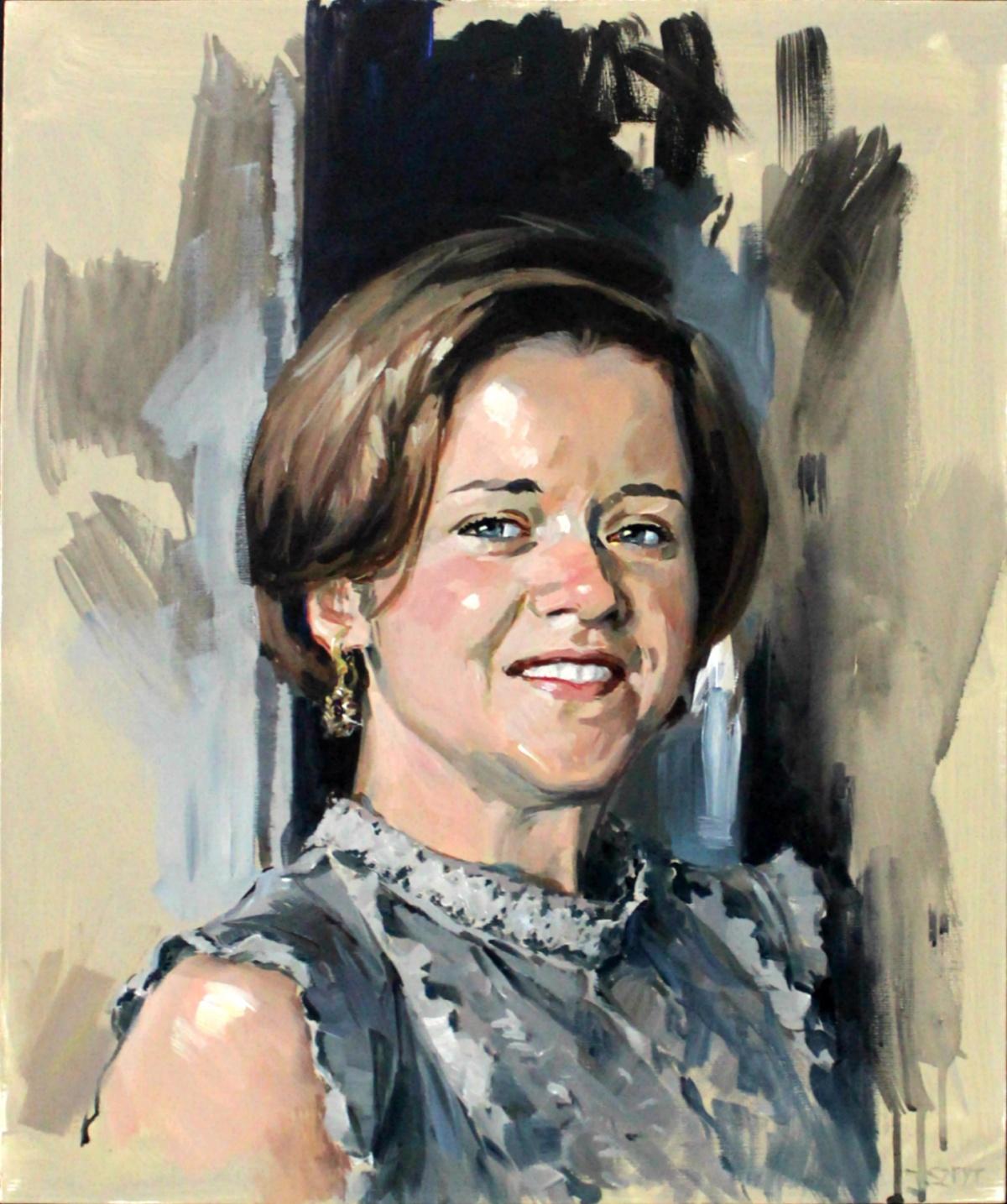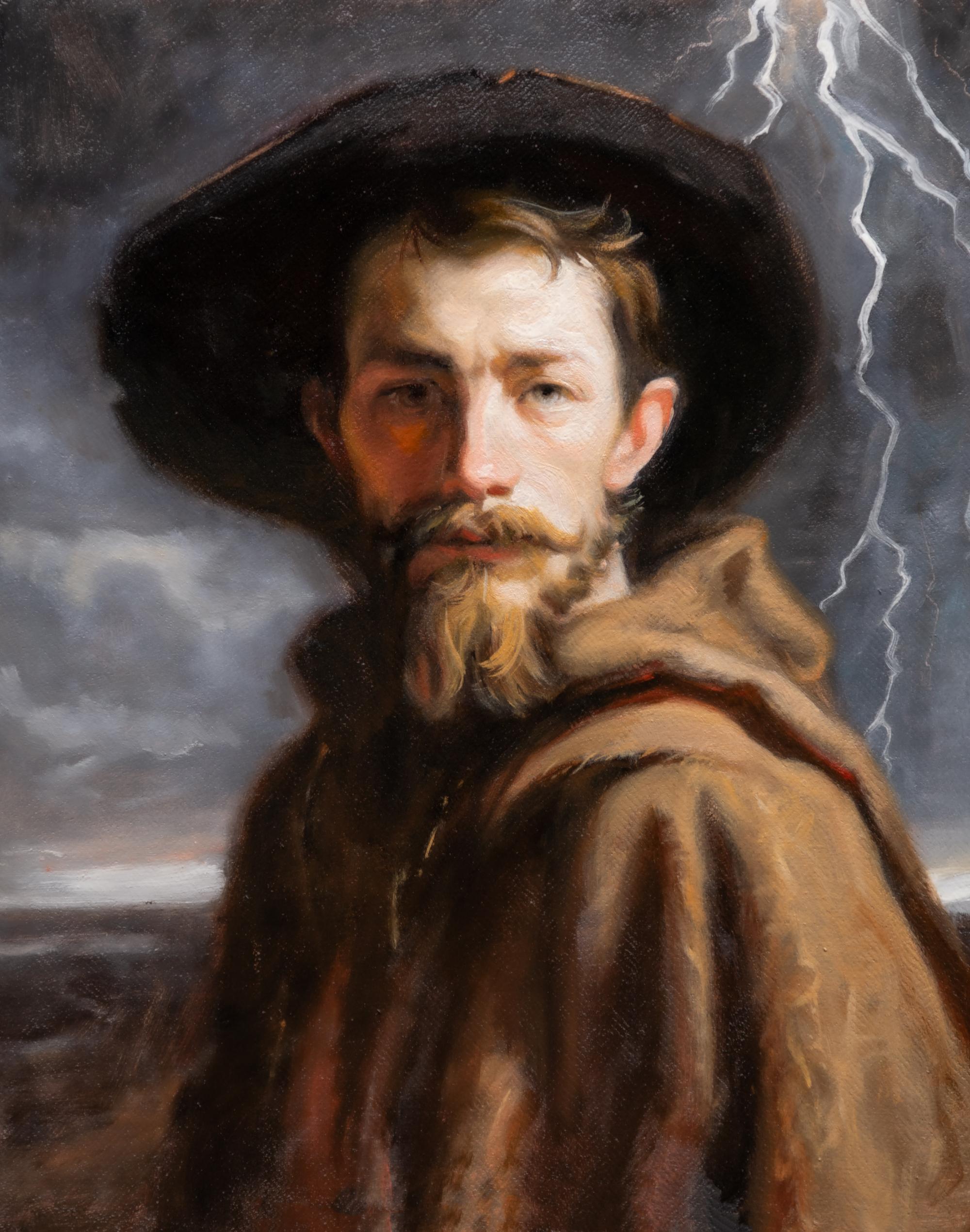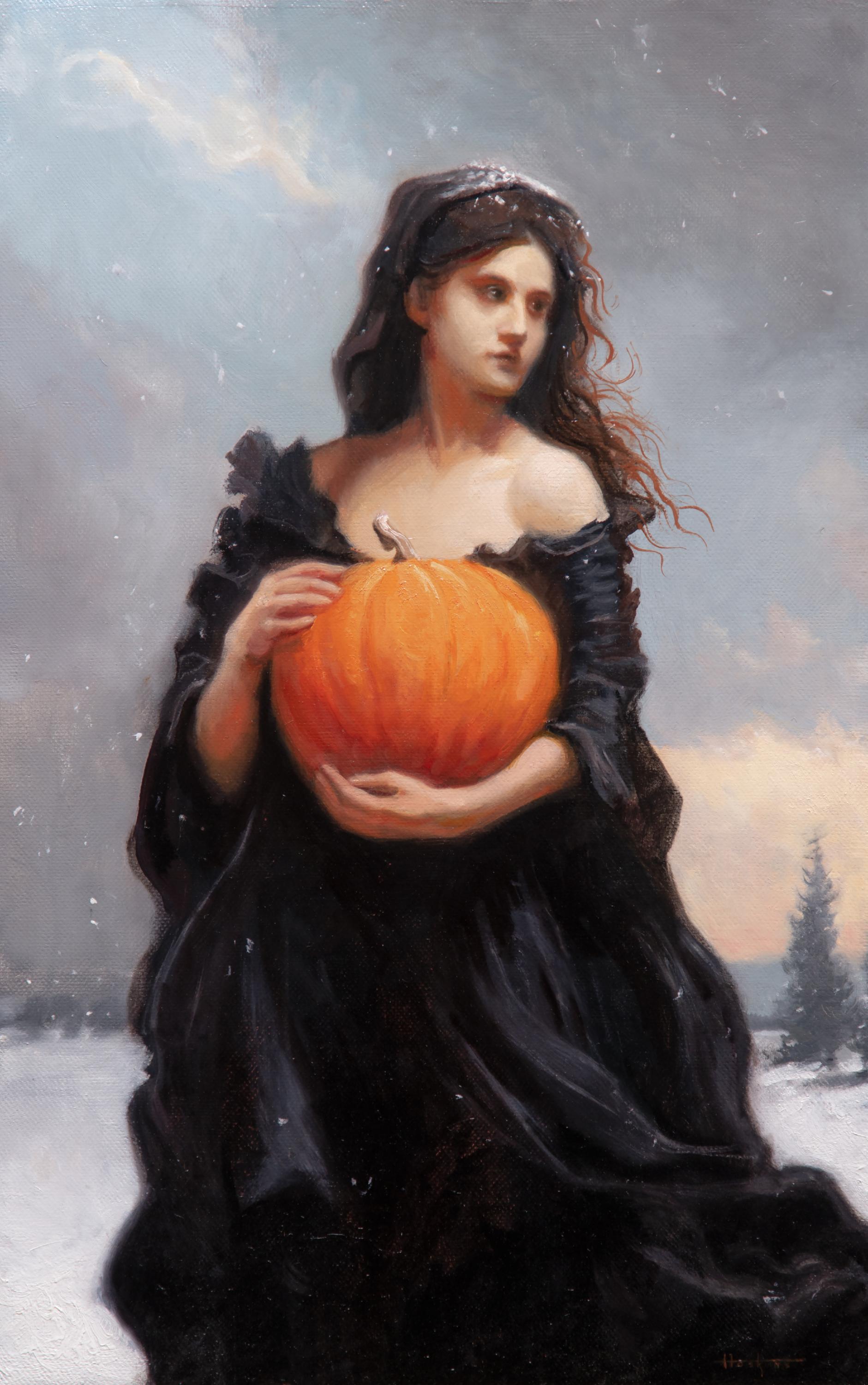Items Similar to BESAME (KISS ME) Oil on Canvas Realism Cuban Art Emerging Artist Framed
Want more images or videos?
Request additional images or videos from the seller
1 of 14
Cristian Mesa VelazquezBESAME (KISS ME) Oil on Canvas Realism Cuban Art Emerging Artist Framed2020
2020
About the Item
BESAME-KISS ME is a new painting from the studio of Cuban artist Cristian Mesa Velazquez. Kiss Me is an oil painting done in the Realist Style of contemporary painting which is oil on canvas. Cristian Mesa Velazquez is known for his figurative and portrait paintings done in the realist style. Cristian studied in several of the best art schools in Cuba and now lives in Barcelona, Spain.
Cristian Mesa has won several art prices from several countries around the world including Luxemburg, Spain and Cuba.
Born in Cuba, Mesa proposes an art that is reminiscent of the great masters of drawing, due to the cleanliness of his line that combines with highly contrasting tones.
On February 18th 2013, the set of five buildings that make up the National School of Arts (ENA) and the Instituto Superior de Arte (ISA) was declared National Monument. The architects Ricardo Porro, Roberto Gottardi and Vittorio Garatti received in Italy the Vittorio de Sica Architecture Award 2012, in recognition of this majestic work.
According to UNESCO, this compound is listed as one of the most important Cuban architectural structures and disseminated internationally. It is considered as a unique and representative monument of an unprecedented historical moment. It fulfills a social and practical function, and also has a high cultural and ideological value, being one of the most outstanding examples of the Modernist Movement in Cuba.
Emergence of a sui generis place STATEMENT:
The National School of Art arises from the need to create a system for arts education in Cuba and achieve its expansion throughout the country. Treasuring our cultural traditions, and conceived as a multidisciplinary center, it gathered the best examples of art in all its manifestations to create the first faculty.
For the first time in history, an art school received students from all social classes and regions, making it majority´s right. The selection is based only on the ability and talent of the candidates, which are subject, prior to admission, to very rigorous and grueling tests.
In the first academic courses, students had to overcome two levels of education (elementary and middle), but in 1976 it was created the ISA for university education of their students.
Expansion of education at the National School of Arts
The National School of Arts began teaching four specialties: ballet, music, drama and visual arts. Later modern and folk dance (1965), Circus (1977) and musical spectacle (1993) were added.
Today it has become the main source of professionals and artists in the country, and has been branched to fulfill the educational needs in 47 subsidiaries in all provinces (24 elementary and 23 middle level), Vocational schools of art and Professional schools of art.
The high demand prevailing in these centers has ensured that the artistic and educational work in every school meets professional excellence, and become ambassadors of development achieved by art education in Cuba.
The National School of Arts is a paradigm of Cuban culture. This demonstrates the prestige and respect achieved by our country is that area within and outside our borders, reflected in our artists, which are recognized throughout the world.
Other paintings by Cristian Mesa Velasquez can be seen in the painting photos.
- Creator:Cristian Mesa Velazquez (Cuban)
- Creation Year:2020
- Dimensions:Height: 20.5 in (52.07 cm)Width: 28 in (71.12 cm)Depth: 2 in (5.08 cm)
- Medium:
- Movement & Style:
- Period:
- Condition:
- Gallery Location:Houston, TX
- Reference Number:1stDibs: LU1405213337422
Cristian Mesa Velazquez
Coco in Paris is a series of four paintings. This is Coco VIII. T The Coco series is by a young Cuban artist now living in Barcelona. Coco series was painted plein air on a recent trip to Paris. The movement and buildings in each painting is different. The color brings out the movement of the woman as she strolls the streets of Paris. This could be the Left of the Right Bank. Cristian leaves it up the the admirer to decide. It could be Montmartre. Framed is 34 x 27. Custom made float frame. Cuban art is becoming popular around the world because of the talented artists and the reasonable prices on their art. Cristian Mesa Velazquez has won several prizes in Cuba and Europe. The Coco series shows the Impressionistic Style with the use of bright colors. Movement can be seen in the painting. The Impressionistic style is seen in all of these Coco paintings. This is Coco VIII out of VIII. The artist recently won an art prize in Luxembourg and is in collections in The Americas and Europe. Born in Cuba, Mesa proposes an art that is reminiscent of the great masters of drawing, due to the cleanliness of his line that combines with highly contrasting tones.
About the Seller
5.0
Gold Seller
These expertly vetted sellers are highly rated and consistently exceed customer expectations.
Established in 1970
1stDibs seller since 2020
119 sales on 1stDibs
Typical response time: <1 hour
- ShippingRetrieving quote...Ships From: Houston, TX
- Return PolicyA return for this item may be initiated within 3 days of delivery.
More From This SellerView All
- The Traveler Oil A Journey Florence Academy Oil Sunny or a Chaotic StormLocated in Houston, TXSamuel S.Hoskins Statement on The Traveler : I hold a deep appreciation for the motif of the traveler. I prefer to perceive my life as a narrative in which I play the role of a traveler. Much like in life itself, this journey involves navigating through various elements and facing the challenges that life presents. At times, the journey may be characterized by sunny and pleasant moments, while at other times, it might resemble a chaotic storm. Nevertheless, there is a profound beauty woven in it all. The Traveler by Samuel Hoskins...Category
2010s Realist Portrait Paintings
MaterialsCanvas, Oil, Linen
- Winter Oil Florence Academy Oil Harvest of Autumn ReflectionLocated in Houston, TXSamuel S.Hoskins Statement on Winter: Delving into the symbolism of winter, I painted a figure dressed in black, embracing the harvest of autumn. In my perspective, winter signifies a moment to take stock of one's life, withdrawing into a state of reflection. It's a time to gaze ahead, anticipating the promises that spring holds for renewal and growth. As a graduate of The Florence Academy of Art and a devoted oil painter, Samuel Hoskins...Category
2010s Realist Figurative Paintings
MaterialsCanvas, Oil, Linen
- White Roses Oil Florence Academy Oil The Enchanting Fragrance of RosesLocated in Houston, TXSamuel S.Hoskins Statement on White Roses: "White Roses" is an endeavor to evoke the enchanting fragrance of roses. One of the most delightful aspects of living in Florence, Italy, is cycling through the outskirts of the city in spring after a refreshing rain shower. The rain seems to awaken the scents of various flora. I utilized Viridian Green and Cerulean Blue to capture the cool contrast that rain imparts to the flowers, seeking to encapsulate the sensory experience of those post-rain, blossoming moments. White Roses 14x18 20x24 with Frame As a graduate of The Florence Academy of Art and a devoted oil painter, Samuel Hoskins...Category
2010s Realist Portrait Paintings
MaterialsCanvas, Oil, Linen
- Sacred Writings Religious and Mythological Narratives Florence Academy OilLocated in Houston, TXSamuel S.Hoskins Statement on Sacred Writing : I sought to delve into the concept of sacred texts, encompassing both religious and mythological narratives. Unlike conventional books, these sacred texts are dynamic, evolving throughout an individual's lifetime and human history. Reading such a text in childhood carries distinct significance compared to revisiting it in later stages of life. To symbolize our transformative journey, I depicted a path leading into the forest, illustrating how our life experiences influence our connection with these profound literary works. Sacred Writing 26x34 28x36 with Frame As a graduate of The Florence Academy of Art and a devoted oil painter, Samuel Hoskins...Category
2010s Realist Figurative Paintings
MaterialsCanvas, Oil, Linen
- After Kupta, Portrait, Realism, Oil Painting, Texas Artist, Sawyer YardsLocated in Houston, TX"After Kupta" 7 x 5 Framed 12 x 10 One of my favorite paintings is the Yellow Scales, a self portrait by Frantisek Kupka hanging in my home city museum, Houston Fine Arts, and whe...Category
2010s Realist Portrait Paintings
MaterialsCanvas, Oil
- Skull, Portrait, Realism, Oil Painting, Texas Artist, Sawyer YardsLocated in Houston, TX"Skull" 7 x 5 Framed 12 x 10 Skull: Small oil on canvas panel of my own backyard, with hint of West Texas. Why are we interested in skulls? Does it br...Category
2010s Realist Portrait Paintings
MaterialsCanvas, Oil
You May Also Like
- Olaf Schneider, "Tiny Dancer", 16x10 Ballet Oil Painting on CanvasBy Olaf SchneiderLocated in Saratoga Springs, NY"Tiny Dancer" by Olaf Schneider is a 16"x10" oil painting on canvas. This life-like painting depicts a brunette ballerina dancer in pose, dressed in blue with a white hair piece tyi...Category
2010s Realist Portrait Paintings
MaterialsCanvas, Oil
- Vinyl - Contemporary Figurative Oil Painting, Realistic Girl PortraitBy Kamil LisekLocated in Salzburg, ATKAMIL LISEK (born in 1980) Studied under the guidance of prof. Maciej Świeszewski at the faculty of painting at the Academy of Fine Arts in Gdansk. He graduated with distinction obta...Category
2010s Realist Figurative Paintings
MaterialsCanvas, Oil
- Ewa - XXI Century, Contemporary Figurative Oil Painting, Realism, PortraitBy Janusz SzpytLocated in Warsaw, PLJanusz Szpyt was born in 1960, he is a Polish painter. He graduated from the Graphic design faculty and painting from the Academy of Fine Arts in Krakow. 1983 onward, he became the m...Category
2010s Realist Portrait Paintings
MaterialsCanvas, Oil
- Erwartungsvoll (oil painting woman portrait hair neck flesh tones vintage art)By Rudolf KosowLocated in Quebec, Quebeckeywords; surrealism, portrait, oil painting, earth tones, figurative painting, strangeness, contemporary surrealistic, unsettling, contemporary figurative painting, dreams, symbolic...Category
2010s Realist Portrait Paintings
MaterialsCanvas, Oil
- Israeli Oil Painting Ruth Schloss Child, Doll, Wagon, Kibbutz Social Realist ArtBy Ruth SchlossLocated in Surfside, FLLarge magnificent colorful Ruth Schloss oil painting of a child with a wagon with a doll or a baby in a carriage stroller.. Signed in Hebrew size measures 31x43 with frame , 23x35.25 without the frame. (this is being sold unframed). Ruth Schloss (22 November 1922 – 2013) was an Israeli painter and illustrator who mainly depicted neglected scenes such as Arabs, transition camps, children and women at eye-level as egalitarian, socialist view via social realism style painting and drawing. Schloss became Israeli painting’s sensitive, conscious, remembering eye. Ruth Schloss was born on 22 November 1922, in Nuremberg, Germany, to Ludwig and Dian Schloss, as the second of three daughters of bourgeois assimilationist Jewish family well-integrated into German culture. As the Nazis came into power in 1933, her family immigrated to Israel in 1937, and settled in Kfar Shmaryahu, then an agricultural settlement. Schloss studied at the Department of Schloss graphic design at "Bezalel" from 1938 to 1942 alongside Friedel Stern and Joseph Hirsch. She was a realistic painter who focused on disadvantaged people in the society and social matters as an egalitarian. Her realism was thus an “inevitable realism,” motivated by an inner necessity: the need to observe reality as it is. Her painting repeatedly addressed the door pulled from its frame, employing drawing’s unique ability to stop time and prolong the image’s persistence in the retina, she repeatedly committed to paper - in a matter-of-fact, non-evasive manner devoid of mystery – man’s tendency to generate chaos, suffering and pain. Throughout her life, Schloss remained minimalist. Painting about human fate was the main subject of her artworks. Her natural inclination was to describe the darker aspect of human existence. 1930s The Schloss household was characterized by open, liberal spirit, in keeping with the parents’ progressive views. It deeply influenced Ruth’s mental development, as she learned to tie culture and art with sensitivity towards the weak and underprivileged. In Jerusalem, she joined a commune of Hashomer Hatzair in which she shaped her socialist views, which she maintained throughout her long career. 1940s In this period she mainly depicted landscapes of kibbutz and wretched women living hard life, children in huger, older people, refugees. After completing her art studies, Schloss joined a training group at Kibbutz Merhavia in 1942, and after two years moved to Karkur region, the nucleus established Kibutz Lehavot Habashan in the Upper Galilee. Through this time, she fell in love with the surroundings and drew landscapes. They are simple and direct with fresh, lucid lines. These paintings were selected as the main works of her first exhibition in 1949. In early 1945, Schloss started to draw illustrations in the children’s magazine Mishmar Leyeladim, and designed the logo of Al Hamishmar, the paper’s new name in 1948. In 1948, upon the founding of Mapam (United Workers’ Party), she designed her party’s emblem, which became a well-known icon. She kept working as an illustrator for Mishmar Layeladim until 1949. "Mor the Monkey" project yielded financial profits and this income was used for a study trip to Paris for two years. She was succesfull as illustrator however, she had inner conflicts of her identity as witnessed painter toward neglected class in Israeli society. First Exhibition at Mikra-Studio Gallery, 1949 She presented forty drawings on paper in her first solo exhibition, representing a selection of the themes of kibbutz landscape, its lifestyle. Schloss confidently proposed her direction through simplicity without using colors in her drawings. 1950s Between 1949 and 1951, she studied at the Académie de la Grande Chaumière in Paris. She began working in oils, with which she continued throughout the 1960s. The exhibition “Back from Paris” opened in November 1951 at Mikra-Studio Gallery . In 1951 she married Benjamin Cohen, who served as chairman of the national leadership of Hashomer Hatzair Workers Party in Tel Aviv. He was a theoretician and a man of principle, highly esteemed by its leaders who became a professor of history at Tel Aviv University. In 1953, following the Mordechai Oren affair and the publication of Moshe Sneh 's followers from Kibbutz Artzi, she and her husband left the kibbutz and moved to the agricultural farm, Kfar Shmaryahu, where she lived until her death. At a certain point in Israeli history, segments of the socialist movement felt that Israel should become part of the Communist bloc, rather than seek the support of the western world. Because the Schloss couple support of Moshe Sneh’s left-wing party, they had to leave the kibbutz. She loved to depict ordinary women as figurative on her painting without hiding or making up anything. The poet Natan Zach wrote about her works in 1955: “Her motto remains that which has been all these years: life as it is, without bluffing." Schloss’s “Pietà” (1953) became a universal cry expressing the pain of mothers on either side of the divide. In the late 1950s, she was the mother of two daughters. When she drew her daughters, unlike the universal babies she depicted, naked and with clenched fists, the painting of her children employed babyish sweetness to the full in a quiet, peaceful and heart-stirring filling rather than urgency. She also painted children in the transition camp and Jaffa in the 1950s and 1960s. 1960s-1980s – The period of Studio in Jaffa Schloss painted at a studio in Jaffa from 1962 till 1983. In this time, she turned her interest to people around her more than kibbutz – the children, mothers, and poor workers, the alleys and houses. She opened the space to the street and its dwellings, built interactions around it, and was nurtured by the presence of the outside in her work. 1960s Schloss familiarized to an Arab woman, Nabava, lived in poor. Schloss returned to painting images of old people later, and she called her painting figurative elderly people in the old age homes “waiting”. In the late 1960s, Ruth discovered acrylic paint and never turn back to oil painting. In 1965 Schloss devoted a series “Area 9 (1965)”, dedicated to the demolition of Israeli-Arab houses and the expropriation of the land, and carried a definite socio-political messages. The series was exhibited at Beit Zvi, Ramat Gan, in 1966. She was the only artist who addressed the result of the Six-Day War immediately afterward. In 1968, Schloss and Gansser-Markus presented “Drawing of War” in Zurich gallery. She expressed the war as an ultimate expression of destruction and ruin, regardless of victors and vanquished. 1970s In late 1970s Schloss began printing the selected photograph directly on the canvas, posterior reworking it in acrylic. She decided to print her work at Har-El Printers in Jaffa, and these became the surface of her painting. This technique was mainly adopted in two large series: Anne Frank (1979-1980) and Borders (1982). Through this technique she placed the figure of elder Frank next to that of the famous young Frank, and released it at the exhibition at Bet Ariela Cultural Center, Tel Aviv, in 1981. The series touched upon the Nazi Holocaust. 1980s The Lebanon War raised the question of “The Good Fence” and the effect of the war. She dedicated a large series Boarders, one of the most powerful image linked to the series is the figure of Yemenite woman raising her hand. She was the first to raise the Black Panthers demonstration to the level of a social icon. In the 1980s and again in 2000, the Intifada uprisings also led Schloss to the easel to render a good number of representational and symbolic works that in their way denounced Israel's political and military actions. 1990s – 2000s Ruth Schloss never had an exhibition in a major Israeli museum. Her works were presented in private galleries and small museums. The main museums, the Tel Aviv Museum of Art and the Israel Museum, included her works only in group exhibitions, and only in 1991 was her retrospective exhibited at the Herzliya Museum. In the 2000s, Schloss’s metaphors turned into animal kingdom and Bedouins in the south. A huge rhinoceros, birds of prey, and other "bad animals," as Cohen Evron, daughter of Ruth, calls them and "I connected this to the Nazis," said Schloss. Schloss' work after she didn't find human expression able to transmit the endless cruelty she saw in Israel's political mentality. Schloss also continued to follow and collect documentary photographs of destructions of houses from the war, the Intifada, the sequence of her work about ruin from 1949 to 2005, was a cumulative testimony about the painful history of Israel and Palestine. In 2006, a large retrospective exhibition of her work was presented at the Museum of Art in Ein Harod, curated by Tali Tamir. Education 1938-41 Bezalel Art Academy, Jerusalem, with Mordecai Ardon 1946 painting course for Kibbutz Artzi artists with Yohanan Simon and Marcel Janco 1949-51 Académie de la Grande Chaumière, Paris Awards and recognition 1965 Silver Medal, International exhibition in Leipzig, Germany 1977 Artist-in-Residence, The Cité Internationale Universitaire de Paris Selected solo exhibitions 2004 “Micha...Category
Mid-20th Century Realist Figurative Paintings
MaterialsCanvas, Oil
- Holy Family with St Elizabeth and Young John Baptist 19th century Oil PaintingLocated in Stockholm, SEThis tender depiction of the Holy Family represents a subject which was central to Raphael's oeuvre. The painting is based on the famous panel by Giulio Romano, called Madonna della ...Category
Late 19th Century Realist Figurative Paintings
MaterialsCanvas, Wood, Oil
Recently Viewed
View AllMore Ways To Browse
Ballet Portrait
Framed Set Of Four Paintings
Cuba Photos
Oil Painting Portrait Folk Art
Cuban Dancers
Kiss Photo
Spanish Canvas 18th
Folk Art Circus
Sui Generis
Porro Italy
Cristian Mesa
Ricardo Mesa
18th Century Portrait Of A Woman
Knight John
Oval Oil Paintings Portraits
Victorian Lady Painting
Going Steady
18th Century Portrait Lady





